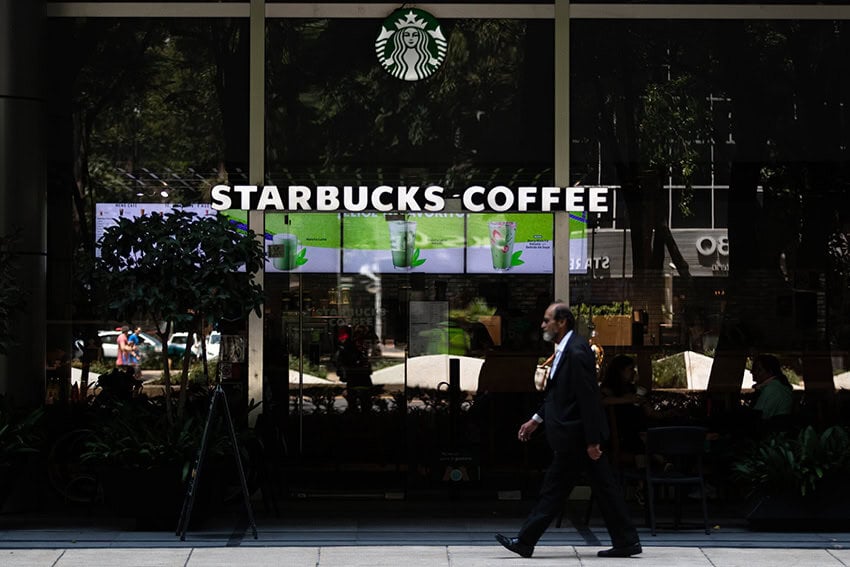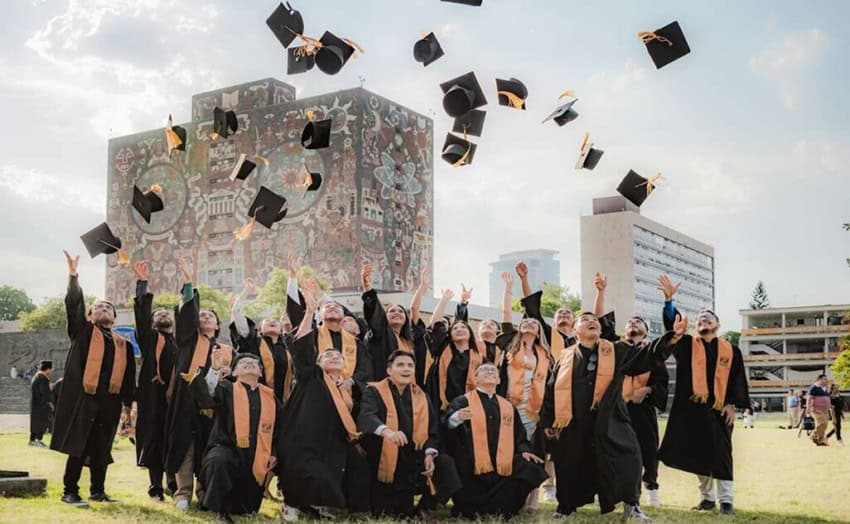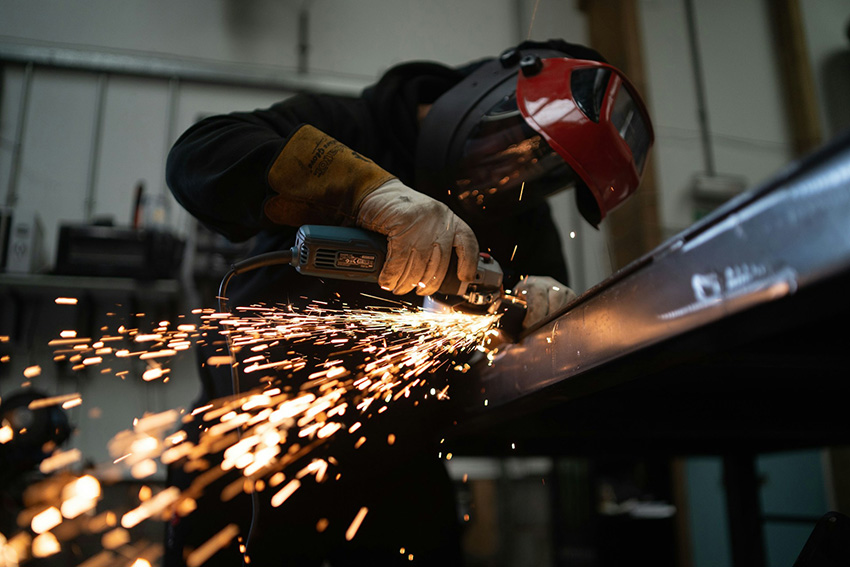Trappings of middle-class life are in plain view in various neighborhoods in Mexico City.
Ubiquitous Starbucks cafes — where the coffee and frappuccinos certainly aren’t cheap — are usually busy. Many parents drop their kids off at private schools in new cars. Malls bustle with shoppers looking for a new iPhone or the latest “must-have” fashion item.

Mexico City is a huge city with plenty of lower-class neighborhoods and low-paid workers, but it is clear that a significant number of chilangos are doing pretty well for themselves. Of course, that is not surprising given that we’re talking about the capital of one of the 15 largest economies in the world.
After speaking to a number of low-paid Mexico City workers earlier this year and writing about some of the financial challenges they face, my focus shifted to Mexico’s middle class, not just in the capital but in other parts of the country as well.
To increase my understanding about this sector of the population, I did a lot of online research, but I also posed the following questions to more than a dozen Mexicans who live in various parts of Mexico, including Mexico City, Mérida, Pachuca and San Miguel de Allende.
- How much does a single person need to earn per month to be part of the middle class in Mexico?
- What about a family with two school-aged kids?
- What does it mean to belong to the middle class?
What is a middle-class income for one person?
The responses to this question ranged from 12,000 pesos (about US $650) on the low end to 40,000 pesos (about US $2,200) on the high end.
“In my opinion being middle class isn’t just about income,” a respondent in Mérida said.
“There are other codes that we need to take into account. But in money I’ll say 15,000 to 30,000 pesos,” he said.
A respondent in San Miguel de Allende opined that a single person could be considered part of the middle class in a small town like Amealco, Querétaro, with a monthly salary of just 12,000 pesos. However, in cities such as León or Celaya in the state of Guanajuato, a person would need to earn 18,000 to 20,000 pesos, she said.
How much does a middle-class family earn?
The responses to this question ranged from 35,000 pesos (about US $1,900) to 90,000 pesos (about US $4,900).
One respondent in San Miguel de Allende said that a household income of 35,000 to 45,000 pesos per month could be sufficient to qualify a four-person family as middle class. However, she stressed that the income a family needs to live a middle-class life is dependent on where in Mexico they live.

Another respondent in San Miguel de Allende said that a household income of 60,000 pesos per month would make a family “upper middle class” in a small Mexican city. The same income in Mexico City would make the family “lower middle class,” she said.
A respondent in Pachuca said that a family would need household income of 55,000 pesos per month to reach middle-class status in that city, the capital of the state of Hidalgo.
The 90,000-peso figure was cited by a respondent in Mexico City, who noted that a mortgage repayment might be one of the various monthly expenses of a middle-class family. The monthly repayment on a 20-year mortgage on a 4-million-peso (US $217,000) apartment is around 40,000 pesos.
What does it mean to be middle class in Mexico?
There were a wide range of responses to this question, but a common thread was that members of the middle class in Mexico have the capacity to access non-essential goods, services and experiences.
“I think the middle class is a [social] construct,” said a respondent in Mérida.
“In that sense, I think it’s made up of an education, a shared culture and material goods,” he said.

Being part of the middle class entails “a formal education — it doesn’t need to be private — being able to work and earn enough money to not just survive but to save as well, and being able to access vacations, social security, transport and culture,” the same respondent said.
Middle-class archetypes
A respondent in San Miguel de Allende described what she considers to be the hallmarks of typical lower-middle-class and upper-middle-class Mexicans.
To be considered lower-middle-class in Mexico, she said, a person or family should own a hatchback or sedan-type car; have a home in “Infonavit areas” (think residential developments with modest tract/cookie cutter housing); be able to regularly buy a good variety of groceries at low-cost supermarkets; take an annual vacation to a beach in Mexico; eat out at a moderately-priced restaurant once a month; and go out to a bar or the movie theater two or three times a month.
A lower-middle-class person doesn’t have private health insurance, and unexpected expenses such as a car repair could throw his or her finances “off balance,” the respondent said.
Similarly, The Economist reported in 2021 that “membership of the middle class in Mexico is far more precarious than in richer places.”
“An economic shock — a family illness or a recession — can send people tumbling back into poverty,” The Economist wrote.

The San Miguel de Allende respondent said that an upper-middle-class person or family has two cars; owns a property that is nicer than “an Infonavit-style home; can regularly buy a good variety of groceries at supermarkets such as H-E-B; sends their children to private schools and can afford after-school activities; goes on vacation within Mexico twice a year; eats out at good restaurants two or three times a month; has private health insurance and car insurance; and buys books and spends “a little more” than most on cultural activities.
Travel, leisure, culture … and money left in the bank
Among the other responses to the question about what it means to belong to the middle class in Mexico were:
- Having a membership to a gym or pool.
- Having at least two decent cars.
- Having a car, medical insurance, a phone, internet and being able to afford to send children to private school.
- Having the capacity to save or invest.
- Being able to cover basic needs such as housing, health care and education, and having “a certain margin” to save and to do “what makes you happy.”
- Having your own business.
- Being able to travel abroad two to three times a year.
- Being able to eat out at restaurants every weekend.
- Being able to go to concerts, museums and the cinema.
- Having healthy food at home.
‘Quantifying the Middle Class in Mexico’
As is evident from the responses above, there are a variety of views about how much an individual, or a family, needs to earn to be considered part of the middle class in Mexico.
But are there official income parameters that can help define who is, and who is not, part of the middle class? During my research, I discovered that the answer is “kind of.” Unfortunately those official parameters are now outdated, and new ones aren’t due to be published until the end of the decade.
The 2021 report “Cuantificando la Clase Media en México 2010-2020” (Quantifying the Middle Class in Mexico 2010-2020) by Mexico’s national statistics agency INEGI states that the average monthly income of a middle-class household was 22,297 pesos (about US $1,200), offering an imperfect but at least tangible income threshold for entry to la clase media mexicana. For urban middle-class households, the average income was slightly higher at 23,451 pesos per month, while for rural middle-class households it was somewhat lower at 18,569 pesos.
Considering that inflation in Mexico has been quite high in recent years, and that the minimum wage almost doubled between 2021 and 2025, a family’s household income would now need to be considerably higher in order for that family to be considered part of the middle class.
Still, an average household income of just over 20,000 pesos in 2021 would indicate that INEGI’s threshold for reaching the middle class in Mexico is lower than that of Mexico News Daily’s respondents.
In 2021, INEGI said that the average upper class household income was 77,975 pesos per month, an amount within the range of what MND respondents said a family would need to earn to be considered middle class. With prices having risen considerably in recent years, it would be reasonable to say that such household income in Mexico City and other expensive areas of Mexico would not make a family upper class in 2025.
What percentage of Mexicans belong to the middle class?
In 2020, 42.2% of households* in Mexico and 37.2% of Mexican people belonged to the middle class, according to INEGI. Those percentages declined compared to 2018, mainly due to the impact of the COVID pandemic on the Mexican economy in 2020.
INEGI hasn’t published data on the size of Mexico’s middle class in more recent years, but it would be reasonable to assume that the the middle class is growing again given that the economy has recovered from the pandemic-induced downturn.
Still, not everyone agrees that around four in 10 people are middle-class in Mexico, which itself is classed as an “upper-middle income” country by the World Bank.
In an article published in 2022 in the magazine “ReVista: Harvard Review of Latin America,” Mexican political scientist Viri Ríos wrote that only 12% of Mexicans were middle-class based on a poverty measurement method developed by the Council of Evaluation of Social Development of Mexico City. Ríos contended that said measure — which takes hourly wages and housing conditions, among other factors, into account — was the best way to measure the size of the middle class.
“Mexico is not a country of middle classes,” she wrote.
“It is a country in which to be middle class is the exception, a level of lifestyle to which very few people have access,” Ríos wrote.
Dependiendo tu fuente, la clase media en 🇲🇽 puede ir del 12% al 45% de la población ¿Por qué? 🤔🤔
Todas tus dudas sobre quién es #ClaseMedia las puedes resolver en este texto que escribí para el Harvard Review of Latin America de @HarvardDRCLAS
— Viri Ríos (@Viri_Rios) March 11, 2022
In The New York Times in 2020, in an opinion article headlined “No, you’re not middle class,” she wrote:
“In Mexico, many believe they belong to the middle class, but that’s not the case. Sixty-one percent of the population identifies as such, but only 12% actually are. Half the country lives under a serious misunderstanding about their income level — a confusion shared equally by the rich and the poor.”
In contrast, economist Valeria Moy wrote in a 2021 article for the El País newspaper that “all the available data … shows that Mexico, to a large extent, is a middle-class country.”
Whether you agree more with Ríos or more with Moy might be shaped, at least in part, by where you live in Mexico and/or the parts of the country you have visited, as INEGI’s data shows that the prevalence of the middle class varies considerably across the nation.
* Per the 2020 statistics, 56.6% of Mexican households belonged to the lower class, while just 1.2% belonged to the upper class. Social mobility in Mexico is considered to be low, with a strong majority of people remaining in the social class in which they were born.
Mexico’s most and least middle-class states
Almost six in ten households in Mexico City are middle class, while fewer than one in five households are middle class in the southern state of Chiapas.
That data also comes from INEGI’s 2021 “Quantifying the Middle Class” report.
INEGI’s data shows that 15 of Mexico’s 32 federal entities have a higher percentage of middle-class households than the national average of 42.2%.
Mexico City is at the top of the list, with 58.9% of households considered middle class. That data might help explain the apparent frappuccino boom.
More than half of all households in six other states are middle-class, according to the INEGI data. They are Colima (54.6%); Jalisco (53.6%); Baja California (53.1%); Sonora (51.9%); Baja California Sur (51.1%); and Querétaro (50.5%).
The other states where the percentage of middle-class households is higher than the national average are Sinaloa, Nayarit, Aguascalientes, México state, Quintana Roo, Nuevo León, Michoacán and Chihuahua. Again, it is important to stress that perceptions of who belongs to the middle class vary, and INEGI’s threshold for entry to said class is considered low by some.
In Mexico’s three poorest states — Chiapas, Guerrero and Oaxaca — the percentage of middle-class households is significantly lower than the national average.
In Chiapas, just 19.5% of households made the grade in 2020, whereas the figures in Guerrero and Oaxaca were 24% and 25.6%, respectively.
In 2019, human development in certain municipalities in those three states was on par with human development in the African nations of Burundi, Burkina Faso and Ethiopia, according to a United Nations report.
Mexico vs. the United States and Canada
Unsurprisingly, the minimum income level required for a household to qualify as middle class in the United States and Canada is higher than in Mexico.
According to Pew Research Center, middle-income households in the United States — those with an income that is two-thirds to double the U.S. median household income — had incomes ranging from about $56,600 to $169,800 in 2022.
The lower figure is almost four times higher than the average annual middle-class household income in Mexico in 2020, which was around US $14,500 (using the current exchange rate).
Also according to Pew, the share of Americans who were middle-class in 2023 was 51%, almost 14 points higher than in Mexico.
In Canada, households with income between CAD $52,875 to $141,000 (US $37,770 to $100,725) qualify as middle-class, according to an OECD definition.
The lower figure is around 2.5 times higher than the average annual middle-class household income in Mexico.
Living expenses are of course higher in the U.S. and Canada than in Mexico — as are salaries.
Which workers generally belong to Mexico’s middle class?
A majority of Mexican workers — almost 55% in Q2 of 2025 — are employed in the informal economy, and most of those people don’t qualify as members of the middle class based on their income levels.
Among the people in formal sector jobs who would normally qualify as members of Mexico’s middle class are medical doctors, engineers, lawyers, finance sector workers and other tertiary-educated professionals.
Many business owners, including restaurateurs and retail store proprietors, would also be considered part of the middle class, as would well-paid workers in Mexico’s large manufacturing sector.

Given that Mexico is one of the 15 largest economies in the world — and is aiming to become the 10th largest in the coming years — there is certainly potential for the Mexican middle class to grow.
Reducing informality in the labor market — no small challenge — will be key to achieving that.
An increase in foreign investment, along with a more equitable spread of that investment across Mexico — as the federal government is aiming to achieve — could also contribute to the growth of the middle class. A positive outcome from next year’s review of the USMCA free trade pact could provide the certainty required to attract more foreign investment, which in turn would help the Mexican economy grow, support job creation and prop up the government’s ambitious Plan México economic initiative.
“Mexico should be a rich country,” Viri Ríos, the Mexican political scientist, wrote in the El País newspaper in 2021.
“We have everything to be one,” she wrote, citing factors including Mexico’s robust trade relationship with the United States, its large working-age population and the strong work ethic of the Mexican people.
The attractiveness of Mexico as tourism destination, the country’s ample renewable energy potential, a still nascent — albeit not guaranteed — nearshoring boom, stable and responsible governance and possibly even lithium mining, among other factors, could also help Mexico become a more prosperous country with a larger middle class in the years and decades ahead.
By Mexico News Daily chief staff writer Peter Davies (peter.davies@mexiconewsdaily.com)
